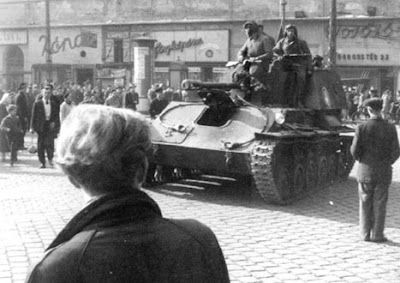I wanted to write a short post about Halloween in Hungary. We Americans are accustomed to Halloween being a festive occasion. Candy and streamers and masks and all kinds of other decorations start appearing in the stores in early September, and Halloween is a time of fun for old and young. The young get to tricker-treat while us older folks get to dress up and go to parties and drink and carry on with our friends. As one of my friends says, it's like "Christmas with your friends."
Not so in Hungary. Halloween has a very different feel. Of course, Hungarians don't celebrate Halloween per se, or Samain, or any other vestige of the Celtic Harvest Feast. You do see some Jack-O-Lanterns in flower shops, or outside a few restaurants, like the ones here outside of the TGI Friday's on Andrassy Blvd. (BTW, I still can't get over walking by TGI Friday's and seeing Hungarians drinking blue beverages with umbrellas in them and eating mozzarella sticks.)
 |
| Jack-O-Lanterns Outside TGI Friday's |
 |
| Hungarian Jack-O-Lantern |
My plans for Halloween had been to visit the House of Terror, which is a museum dedicated to the crimes of Hungary's notorious secret police. I walk past this museum daily, and I never cease to snicker at the name, which sounds like a Rotary Club haunted house more than a museum dedicated to those who died violently at the hands of the secret police under the Hungarian Communist Regime. I soon realized that Halloween is a national holiday here, and nothing is open. Not to mention, Halloween was on a Monday, and it's hard to find a museum in Europe open on a Monday.
October 31 is not a holiday because of Halloween, however. October 31 marks the date that Hungary withdrew from the Warsaw Pact in 1956, after a group of students and protesters published what is known as The Sixteen Points. These points demanded things like more personal freedom, more food, the removal of the secret police, and the the withdrawal of the Soviets. Pretty basic things. Here is a picture of students and what the Russians called "hooligans" tearing down a statue of Stalin.
 |
| Protestors with a Decapitated Stallin |
The Russians responded with unexpected brutality. On November 4, 1956 Russia sent in tanks, and at least 30,000 Hungarians were killed. The killings were atrocious. In some cases the Russians ran down the wounded in tanks. The prime minister Imre Nagy was executed and buried in an unmarked grave.
Here is a picture of the tanks.
 |
| Russian Tanks Invading Budapest in November 1956 |
 |
| Russian Tank in Budapest 1956 |
Here is a Hungarian Freedom Fighter.
Here are tanks rolling down Andrassy Boulevard which is right down the street from my house.
 |
| Russian Tanks on Andrassy Korut |
 |
| The Dead |
You can imagine, then, that October 31 is not a cheerful day. With All Saint's Day following it, the day when the dead are remembered, it's a very solemn period. I thought Sundays here were boring and depressing, but I've never seen anything like Budapest October 30 through November 2. Depressing doesn't even begin to do it justice.
At the end of my street, Izabella, Andrassy ut runs through much of the city---from one end to the other almost. People had tacked up pictures on the trees of loved-ones who were killed during the uprising, on the spot where they had died. They had put candles and flowers and wreaths under the photographs. It was sobering to walk down the street and pass the place where people had been gunned down, and to imagine what it must have been like on those days.











No comments:
Post a Comment